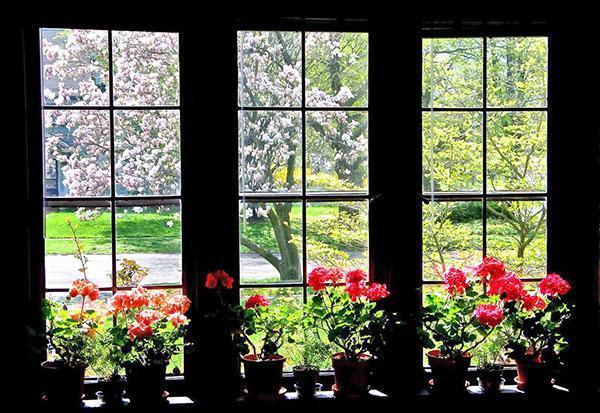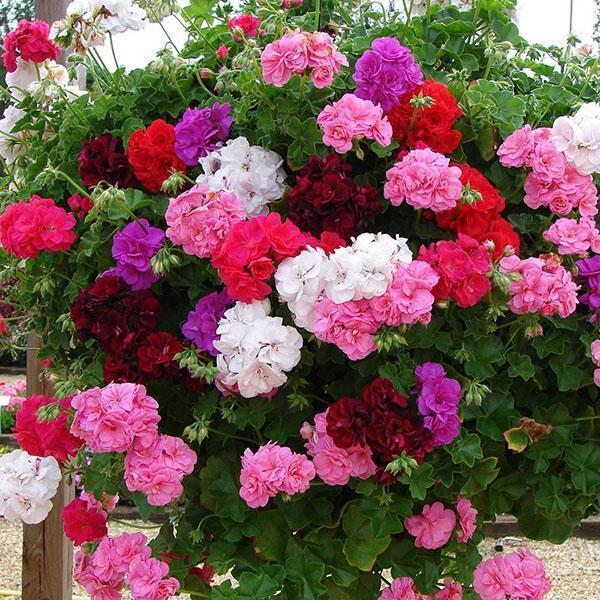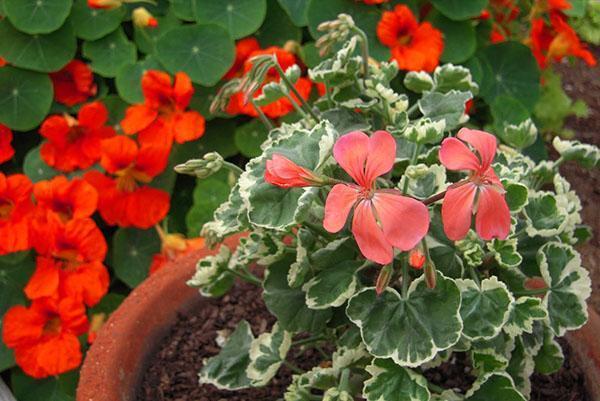Types and varieties of room geranium in the photo with a description
 Undemanding to care, blooming for several months and such bright pelargoniums are often called geraniums due to their similarity. But nevertheless, this is a separate numerous genus, and photos of species and varieties of indoor geraniums will help to understand the existing diversity of these amazing plants native to South Africa.
Undemanding to care, blooming for several months and such bright pelargoniums are often called geraniums due to their similarity. But nevertheless, this is a separate numerous genus, and photos of species and varieties of indoor geraniums will help to understand the existing diversity of these amazing plants native to South Africa.
Such different indoor geraniums

They can be wide, almost rounded, figuratively cut, finger-like, smooth corrugated, green and variegated.
The long-standing fame of indoor geraniums as spectacular and unpretentious plants has led to the fact that for the last hundred years:
- a great variety of varietal forms of pelargonium were obtained;
- wild species were discovered and cultivated;
- interspecific hybrids appeared.
 Therefore, the modern classification of the genus presents to plant lovers about 250 independent species, and the gradation of varieties of indoor plants, adopted in the international community of florists, suggests using their designations based on external signs, as in the photo, varieties and types of indoor geranium:
Therefore, the modern classification of the genus presents to plant lovers about 250 independent species, and the gradation of varieties of indoor plants, adopted in the international community of florists, suggests using their designations based on external signs, as in the photo, varieties and types of indoor geranium:
- Stellar - star-shaped indoor geraniums, their varieties and hybrids;
- Tulip - tulip pelargoniums;
- Unique - indoor geraniums are unique;
- Zonal are zonal or edged domestic pelargonium species.
- Angel - indoor geraniums are angels;
- Colored Foliage - variegated varieties;
- Cactus - cactus pelargonium;
- Ivy-leaved - ivy geraniums, which can be standard sizes, as well as dwarfs and miniatures;
- Miniature and Dwarf - miniature and dwarf indoor pelargonium plants;
- Regal - royal geraniums
- Scented-leaved - scented geraniums.
Pelargonium zonal or edged (Pelargonium zonale)
 All kinds of hybrids and varieties of this type of room geranium, as in the photo, grow well in the house, on balconies and even on city flower beds. This is the undoubted leader in popularity and the number of cultivated varieties, of which today there are about 75 thousand.
All kinds of hybrids and varieties of this type of room geranium, as in the photo, grow well in the house, on balconies and even on city flower beds. This is the undoubted leader in popularity and the number of cultivated varieties, of which today there are about 75 thousand.
Among other domestic perennial geraniums, zonal plants are easily recognized by the characteristic color of the foliage. Against a bright green background, darker areas are clearly visible, which gave the name to the whole type of indoor geraniums, as in the photo. The flowers of the zonal pelargonium can be either simple or double.
 When describing geranium varieties, in the photo, and in the names of plants, the following gradation is used according to the number of petals in the corolla:
When describing geranium varieties, in the photo, and in the names of plants, the following gradation is used according to the number of petals in the corolla:
- non-double flowers have five petals - Single;
- semi-double flowers include 6 to 9 petals and are designated Semi-Double;
- double geranium flowers consist of 8 or more petals - Double.
Terry varieties are sometimes called peony geraniums, which is somewhat incorrect. There is no such group of plants in the internationally recognized classification.
 The flowers of the zonal geranium differ not only in splendor and size. Long gone are the days when only red geraniums flaunted on the windows.
The flowers of the zonal geranium differ not only in splendor and size. Long gone are the days when only red geraniums flaunted on the windows.
Depending on the variety and variety, pelargonium pleases the eye with umbrella inflorescences of all shades of pink, cream, burgundy or raspberry.Plants with white, multicolored and even yellow corollas are not uncommon, as in the photo of a geranium variety called First Yellow Improved.
 But these are not all the strengths of room geranium. Varieties with a flower shape uncharacteristic for the species are of particular attention to florists.
But these are not all the strengths of room geranium. Varieties with a flower shape uncharacteristic for the species are of particular attention to florists.
Rosaceae (Rose-bud Zonal pelargoniums)
 An example is the pink geranium, as in the photo, with spectacular double flowers, which in structure and appearance resemble miniature English roses.
An example is the pink geranium, as in the photo, with spectacular double flowers, which in structure and appearance resemble miniature English roses.
This variety of indoor geranium, its name and photos of flowers have been known in the world since the century before last. The first information about plants was published in the Horticultural Herald of the Royal Society of Britain in 1876. But in our country, rosaceous varieties are not yet widespread and are found only in the collections of the most enthusiastic florists.
Tulip indoor geraniums (Tulipe-bud pelargonium)
 A century later, flower growers received home geranium plants with flowers that, even at the time of full bloom, do not open, remaining in the bud stage.
A century later, flower growers received home geranium plants with flowers that, even at the time of full bloom, do not open, remaining in the bud stage.
As a result, this indoor geranium, shown in the photo, was called tulip-shaped. The origin of the variety was given by a spontaneous mutation, and the few varieties and hybrids of tulip geranium that exist today, when grown or reproduced, sometimes try to return to their natural form.
Stellar indoor geraniums (Stellar Zonal Pelargonium)
 In the middle of the last century, Australian flower growers managed to obtain indoor geraniums, which have an original corolla shape, not similar to the varieties that existed before.
In the middle of the last century, Australian flower growers managed to obtain indoor geraniums, which have an original corolla shape, not similar to the varieties that existed before.
Because of the acute-angled narrowed petals, indoor geranium, in the photo, was called star-shaped.
Currently, varieties and hybrids are at the disposal of flower growers not only with simple and double flowers of all shades, but also star-shaped pelargoniums with bright multicolored foliage.
Cactus indoor geraniums (Cactus Pelargonium)
 The cactus geraniums obtained at the turn of the 20th century are extremely rare today. A characteristic feature of these plants is large flowers with narrowed, sometimes needle-like petals, giving the corolla a scruffy disheveled look.
The cactus geraniums obtained at the turn of the 20th century are extremely rare today. A characteristic feature of these plants is large flowers with narrowed, sometimes needle-like petals, giving the corolla a scruffy disheveled look.
Carnation Pelargonium (Carnation Pelargonium)
 Indoor geraniums, in the photo, amaze with a variety of flowers, colors and species. One of the most unusual is the carnation variety of zoned pelargonium, with serrated petals that resemble carnation flowers.
Indoor geraniums, in the photo, amaze with a variety of flowers, colors and species. One of the most unusual is the carnation variety of zoned pelargonium, with serrated petals that resemble carnation flowers.
Pelargonium ivy (Ivy-leaved Pelargonium)
 Most of the ampelous varieties of indoor geranium, as in the photo, belong to the vast group of pelargoniums and leaves that resemble dense green ivy foliage. Because of this similarity, numerous varieties with simple and large double flowers are called ivy.
Most of the ampelous varieties of indoor geranium, as in the photo, belong to the vast group of pelargoniums and leaves that resemble dense green ivy foliage. Because of this similarity, numerous varieties with simple and large double flowers are called ivy.
Trumpet geraniums, as in the photo, are plants with creeping or creeping stems reaching a meter in length. In culture, such varieties are indispensable for vertical gardening and for decorating hanging baskets. Indoor pelargoniums are also used as ground cover plants.
The leaves of the ampelous geranium are dense, leathery, in contrast to the zonal variety, completely smooth.
The variegated forms of ivy geraniums, as in the photo, are very interesting.
Royal Pelargonium (Regal Pelargonium)
Many indoor geraniums have been obtained as a result of selection work and hybridization between species. Thanks to such efforts, royal pelargoniums appeared with flowers up to 7 cm in diameter.
 The peculiarity of these varieties and hybrids is not only in the size of simple and semi-double corollas, but also in their multicolored color. The petals must have spots, streaks or specks of contrasting tones.
The peculiarity of these varieties and hybrids is not only in the size of simple and semi-double corollas, but also in their multicolored color. The petals must have spots, streaks or specks of contrasting tones.
Pelargonium Angels (Angel Pelargonium)
 Pelargonium Angels in appearance resemble plants of the "royal" variety. But the flowers here are somewhat smaller, and the existing varieties were obtained from crossing pelargonium curly with large-flowered.
Pelargonium Angels in appearance resemble plants of the "royal" variety. But the flowers here are somewhat smaller, and the existing varieties were obtained from crossing pelargonium curly with large-flowered.
Angels are mainly ampelous geraniums, as in the photo, forming a lush crown of shoots with medium-sized monophonic foliage.
Unique Pelargonium
 Hybrid plants obtained from royal pelargonium and brilliant, began to be called unique. This group belongs to the oldest varieties, although it is not so easy to find plants in the collections of gardeners.
Hybrid plants obtained from royal pelargonium and brilliant, began to be called unique. This group belongs to the oldest varieties, although it is not so easy to find plants in the collections of gardeners.
Although the flowers of this variety, as in the photo of the room geranium, look like the flowers of royal plants, they are much smaller. But the foliage is often dissected, corrugated, and also has a pleasant smell.
 For example, the greens in the pictured geranium called Paton's Unique have a sweet, fruity aroma.
For example, the greens in the pictured geranium called Paton's Unique have a sweet, fruity aroma.
Scented-leaved Pelargonium
 It was the smell of crushed geranium leaves that attracted a person's attention to this plant. Until the century before last, the main focus in the selection of indoor geraniums was not the beauty of the flowers, but the aroma, because the plants served as "living deodorants".
It was the smell of crushed geranium leaves that attracted a person's attention to this plant. Until the century before last, the main focus in the selection of indoor geraniums was not the beauty of the flowers, but the aroma, because the plants served as "living deodorants".
Similar varieties and hybrids of scented geraniums are popular today. They will not amaze with their bright flowering or the shape of inflorescences, but they are also used for flavoring culinary dishes and for household fragrances when storing bed linen or outerwear.
 Depending on the type and variety, as in the photo, room geranium, its leaves can smell of all kinds of fruits, mint and roses, nutmeg, carrots or needles.
Depending on the type and variety, as in the photo, room geranium, its leaves can smell of all kinds of fruits, mint and roses, nutmeg, carrots or needles.
I love flowers
Tell me, why does the fragrant geranium dry at the edges and crumble? Found a hundred tips for pelargonium - and none for scented.
Considering that fragrant geranium is still one of the varieties of pelargonium (they are also geraniums), then all the recommendations apply to it, as to the latter. Geranium leaves, including fragrant ones, begin to turn yellow, dry and crumble from too high temperature and drafts. If the buds are also crumbling, then the reason must be sought in watering, in particular, in overdrying the soil. Eliminate the cause - and the bush will be green and beautiful again.
In addition, pests may also be involved in the drying out of the aerial part. They feed on sap from leaves, buds and even shoots of pelargoniums. This is how the results of the activity of spider mites, aphids, and mealybugs are manifested. If you do find pests, then the most effective way is to treat the bush with insecticides. Do not forget that first of all, the state of the leaves worsens in case of geranium diseases. Then they are treated with fungicides, for example, Fundazol.